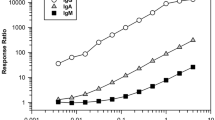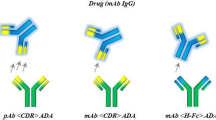Abstract
Antibody drugs have been widely used to treat many diseases and are the fastest-growing drug class. IgG1 is the most common type of antibody because of its good serum stability; however, effective methods for the rapid detection of IgG1-type antibodies are lacking. In this study, we designed two aptamer molecules derived from the reported aptamer probe that has been proven to bind to the Fc fragment of the IgG1 antibody. The results showed that Fc-1S could specifically bind to the human IgG1 Fc proteins. In addition, we modified the structure of Fc-1S and constructed three aptamer molecular beacons that could quantitatively detect IgG1-type antibodies within a short time. Furthermore, we unveiled that the Fc-1S37R beacon has the highest sensitivity for IgG1-type antibodies with a detection limit of 48.82813 ng/mL and can accurately detect serum antibody concentrations in vivo with consistent results to ELISA. Therefore, Fc-1S37R is an efficient method for the production monitoring and quality control of IgG1-type antibodies to enable the large-scale production and application of antibody drugs.







Similar content being viewed by others
Data Availability
All data generated and analyzed during this study are included in this article.
References
Parr, M. K., Montacir, O., & Montacir, H. (2016). Physicochemical characterization of biopharmaceuticals. Journal of Pharmaceutical and Biomedical Analysis, 130, 366–389.
Strohl, W. R. (2018). Current progress in innovative engineered antibodies. Protein & Cell, 9(1), 86–120.
Carter, P. J., & Lazar, G. A. (2018). Next generation antibody drugs: Pursuit of the “high-hanging fruit”. Nature Reviews. Drug Discovery, 17(3), 197–223.
Schumacher, D., et al. (2016). Current status: Site-specific antibody drug conjugates. Journal of Clinical Immunology, 36(Suppl 1), 100–107.
Kohler, G., & Milstein, C. (1975). Continuous cultures of fused cells secreting antibody of predefined specificity. Nature, 256(5517), 495–497.
McLaughlin, P., et al. (1998). Rituximab chimeric anti-CD20 monoclonal antibody therapy for relapsed indolent lymphoma: Half of patients respond to a four-dose treatment program. Journal of Clinical Oncology, 16(8), 2825–2833.
Yu, J., Song, Y., & Tian, W. (2020). How to select IgG subclasses in developing anti-tumor therapeutic antibodies. Journal of Hematology & Oncology, 13(1), 45.
Yang, G., et al. (2020). Screening of aptamer for human IgG Fc fragment by capillary electrophoresis-systematic evolution of ligands by exponential enrichment. Chinese Journal of Analytical Chemistry, 48(5), 601–607.
Andersen, C. B., et al. (2010). Aggregation of a multidomain protein: A coagulation mechanism governs aggregation of a model IgG1 antibody under weak thermal stress. Protein Science, 19(2), 279–290.
Robertson, J., et al. (2016). Essential medicines for cancer: WHO recommendations and national priorities. Bulletin of the World Health Organization, 94(10), 735–742.
Goydel, R. S., & Rader, C. (2021). Antibody-based cancer therapy. Oncogene, 40(21), 3655–3664.
Ellington, A. D., & Szostak, J. W. (1990). In vitro selection of RNA molecules that bind specific ligands. Nature, 346(6287), 818–822.
Acquah, C., et al. (2015). A review on immobilised aptamers for high throughput biomolecular detection and screening. Analytica Chimica Acta, 888, 10–18.
Sun, H., & Zu, Y. (2015). A highlight of recent advances in aptamer technology and its application. Molecules, 20(7), 11959–11980.
Hamula, C., et al. (2011). Selection and analytical applications of aptamers binding microbial pathogens. Trends Analyt Chem, 30(10), 1587–1597.
Yoshida, H., et al. (2020). Binding interaction analysis of RNA aptamer-Fc region of human immunoglobulin G using fragment molecular orbital calculation. Chemical Physics Letters, 738, 136854.
Cai, R., et al. (2019). Functional chimera aptamer and molecular beacon based fluorescent detection of Staphylococcus aureus with strand displacement-target recycling amplification. Analytica Chimica Acta, 1075, 128–136.
Feng, X., et al. (2019). Quantitative detection and real-time monitoring of endogenous mRNA at the single live cell level using a ratiometric molecular beacon. ACS Applied Materials & Interfaces, 11(32), 28752–28761.
Sherrill-Mix, S., et al. (2021). Detection of SARS-CoV-2 RNA using RT-LAMP and molecular beacons. Genome Biology, 22(1), 169.
Hong, P., Li, W., & Li, J. (2012). Applications of aptasensors in clinical diagnostics. Sensors (Basel), 12(2), 1181–1193.
Sharma, A., et al. (2016). Development of structure switching aptamer assay for detection of aflatoxin M1 in milk sample. Talanta, 158, 35–41.
Yang, C. J., et al. (2005). Light-switching excimer probes for rapid protein monitoring in complex biological fluids. Proc Natl Acad Sci U S A, 102(48), 17278–17283.
Shi, H., et al. (2011). Activatable aptamer probe for contrast-enhanced in vivo cancer imaging based on cell membrane protein-triggered conformation alteration. Proc Natl Acad Sci U S A, 108(10), 3900–3905.
Zhao, B., et al. (2015). Designing activatable aptamer probes for simultaneous detection of multiple tumor-related proteins in living cancer cells. Biosensors & Bioelectronics, 68, 763–770.
Walsh, G. (2018). Biopharmaceutical benchmarks 2018. Nature Biotechnology, 36(12), 1136–1145.
Chen, K., et al. (2020). Aptamers as versatile molecular tools for antibody production monitoring and quality control. Journal of the American Chemical Society, 142(28), 12079–12086.
Bellassai, N., D’Agata, R., & Spoto, G. (2021). Novel nucleic acid origami structures and conventional molecular beacon-based platforms: A comparison in biosensing applications. Analytical and Bioanalytical Chemistry, 413(24), 6063–6077.
Li, B., et al. (2022). The source structure design of the rotating magnetic beacon based on phase-shift direction finding system. Sensors (Basel), 22(21), 8304.
Moutsiopoulou, A., et al. (2019). Molecular aptamer beacons and their applications in sensing, imaging, and diagnostics. Small (Weinheim an der Bergstrasse, Germany), 15(35), 1902248.
Brylev, V. A., et al. (2021). Molecular beacon DNA probes with fluorescein bifluorophore. Russian Journal of Bioorganic Chemistry, 47(3), 734–740.
Saisuk, W., et al. (2022). A molecular beacon biosensor for viral RNA detection based on HyCaSD strategy. Analytica Chimica Acta, 1221, 340134.
Acknowledgements
We thank Puze Long for excellent technical support. This work was supported by the Guangxi Natural Science Foundation Program (Grant numbers [2019GXNSFDA245031; 2021GXNSFAA220097]).
Author information
Authors and Affiliations
Contributions
All authors contributed to the study’s conception and design. Material preparation, data collection, and analysis were performed by Cai-Wen Duan, Kai-Ming Chen, Ke-Yang, Wei-Wei Zheng, and Xiu-Song Huang. The first draft of the manuscript was written by Cai-Wen Duan and Ke-Yang. All authors read and approved the final manuscript.
Corresponding authors
Ethics declarations
Ethical Approval
Permission from the Institutional Animal Ethical Committee was received before making these experiments.
Consent to Participate
Not applicable.
Consent for Publication
Not applicable.
Conflict of Interest
The authors declare no competing interests.
Additional information
Publisher's Note
Springer Nature remains neutral with regard to jurisdictional claims in published maps and institutional affiliations.
Supplementary Information
Rights and permissions
Springer Nature or its licensor (e.g. a society or other partner) holds exclusive rights to this article under a publishing agreement with the author(s) or other rightsholder(s); author self-archiving of the accepted manuscript version of this article is solely governed by the terms of such publishing agreement and applicable law.
About this article
Cite this article
Yang, K., Zheng, WW., Huang, XS. et al. Application of a Novel Aptamer Beacon for Rapid Detection of IgG1 Antibody Drugs. Appl Biochem Biotechnol 195, 7075–7085 (2023). https://doi.org/10.1007/s12010-023-04471-4
Accepted:
Published:
Issue Date:
DOI: https://doi.org/10.1007/s12010-023-04471-4





